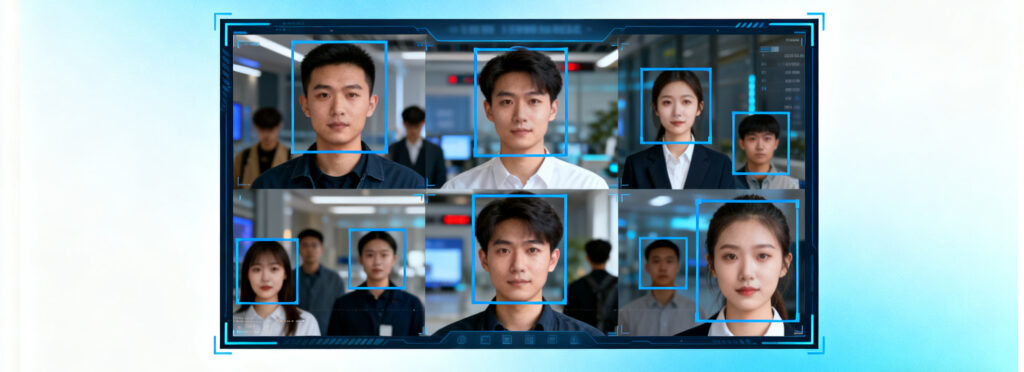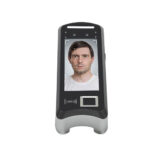Why Fast Face Recognition Is Essential in High-Traffic Environments
As organizations deal with larger populations and increasing security demands, slow or manual identity verification methods—like ID cards, passwords, fingerprint scanners, and QR code scanning—are no longer efficient. They create queues, slow down traffic, and increase operational costs.
Fast face recognition enables high-throughput access control, allowing users to walk naturally through gates while being identified in real time. By eliminating physical touch and reducing verification steps, this technology improves user experience and reduces waiting times during peak hours.
High-Speed Biometric Authentication in Busy Access Points
Fast face recognition can identify individuals in just 0.2–0.5 seconds, even when they are in motion. AI-powered algorithms process multiple frames per second, ensuring continuous traffic flow. As a result, entry points that once relied on slow manual checks can now handle significantly more people each minute—a major advantage for high-density facilities such as schools, factories, airports, and mass transit hubs.
Reducing Bottlenecks with Contactless AI Face Recognition
In high-traffic areas, contactless verification is essential. Traditional fingerprints or card-based systems require users to stop, touch a sensor, or pull out credentials—creating congestion and longer processing times. Fast face recognition removes these obstacles through fully touchless facial authentication, ensuring smooth movement even when thousands of people arrive simultaneously, such as at shift changes, school start times, or peak transit periods.
How Fast Face Recognition Works
AI Face Detection and Real-Time Facial Tracking
Modern facial recognition cameras use high-resolution RGB and infrared sensors to instantly detect a face within crowded or fast-moving environments. AI tracking ensures the system maintains focus as the user walks past, enabling accurate recognition without requiring the person to stop or pose.
Facial Feature Extraction Using Deep Learning Algorithms
Once a face is detected, deep neural networks extract a unique biometric feature map. These algorithms evaluate facial landmarks, 3D depth information, skin texture patterns, and spatial geometry. Because the extracted feature vector is highly detailed, the system can achieve high accuracy even in challenging lighting conditions or when users wear glasses, hats, or masks.
Liveness Detection for Anti-Spoofing Security
Security is strengthened with multi-layered liveness detection. Infrared depth imaging, micro-texture analysis, and motion pattern recognition work together to prevent unauthorized access from photos, videos, printed images, or 3D masks. AI-driven anti-spoofing ensures the individual being scanned is a real, live person.
Ultra-Fast Biometric Matching for High-Traffic Access Control
After liveness verification, biometric templates are matched to the database within milliseconds. Modern systems support tens of thousands of users without compromising speed. This makes AI-powered fast face recognition ideal for large enterprises, public transit hubs, and campuses requiring fast and reliable identity authentication.
Key Features of Fast Face Recognition Systems
Fast face recognition is engineered not only for speed but also for stability, scalability, and real-world performance.
High-Speed ID
Fast face recognition systems deliver instant identification—often within 0.2 seconds—thanks to AI-powered algorithms and high-performance processors. They can handle continuous face flow in crowded areas such as metro stations, airports, schools, and office buildings without delay. The high throughput ensures smoother access control and reduces queues during peak hours.
Accurate in Any Environment
Modern AI facial recognition devices maintain high accuracy in complex environments, including low light, strong backlight, outdoor sunlight exposure, or fast-moving crowds. Advanced HDR imaging, infrared sensors, and 3D depth cameras ensure reliable detection regardless of weather, lighting, or user height variations—making them ideal for high-traffic outdoor access points.
Multi-Biometric Support
Many high-speed face recognition terminals integrate multiple biometric technologies such as palm vein recognition, fingerprint identification, QR code, NFC card, and ID document verification. Multi-modal authentication enhances flexibility for access control, visitor management, and time attendance in smart buildings and large facilities.
Strong Anti-Spoofing
Fast face recognition systems include liveness detection powered by AI and depth-sensing technology. They can prevent spoofing attempts from printed photos, video replay, silicone masks, and deepfake attacks. This ensures high-security authentication for environments requiring strict identity verification, such as government buildings, research institutes, financial centers, and industrial parks.
Easy Integration
The latest AI recognition terminals support rapid deployment and seamless integration with access control systems, turnstile gates, attendance software, elevator control, and third-party security platforms. With SDKs, APIs, and cloud compatibility, they can be easily connected to enterprise management systems for centralized monitoring and remote configuration.
Related facial recognition products
Applications in High-Traffic Access Points
Corporate Buildings and Office Complexes – Fast facial recognition enables smooth employee entry during peak hours, enhances security, and supports attendance tracking.
Factories and Industrial Parks – Efficient verification for shift changes, prevents buddy punching, and maintains high throughput at gates.
Schools, Universities, and Educational Campuses – Contactless student and staff verification, fast entry during morning rush, library access, dormitory control.
Airports, Metro Stations, and Public Transit Hubs – Quick passenger identity checks, seamless ticketing integration, faster boarding, high throughput management.
Residential Communities and Smart Buildings – Rapid resident access, secure visitor management, keyless entry, integration with community security systems.
Stadiums, Exhibition Centers, and Event Venues – High-volume crowd entry, ticket verification, fast security checks, improved crowd control.
Government Buildings and High-Security Facilities – Authorized personnel verification, secure entry for sensitive areas, integration with multi-layered security systems.
Hotels and Hospitality – Guest check-in, room access, VIP area control, fast and contactless entry.
Hospitals and Healthcare Facilities – Patient identification, staff access control, secure and hygienic entry points, compliance with safety regulations.
Financial Institutions and Banking Centers – High-security access to vaults, teller areas, and server rooms, integration with biometric payment and verification.
Logistics Hubs and Warehouses – Rapid worker identification, secure access for delivery staff, integration with automated gate systems.
Conference Centers and Large Offices – Fast attendee verification, smooth registration, restricted area access management.
Educational Examination Centers – Student identity verification, secure and fast entry for large numbers of examinees.
Conclusion
Fast face recognition is transforming high-traffic access control systems across industries. Its ability to combine speed, accuracy, hygiene, and security makes it an essential technology for modern smart buildings, public transportation hubs, educational institutions, and industrial facilities. With AI-powered touchless authentication and robust anti-spoofing defenses, organizations can process thousands of users efficiently while maintaining strict identity verification standards. As demand for frictionless and secure access continues to grow, fast facial recognition will remain at the forefront of biometric technology.
Contactez-nous
We would love to speak with you.
Feel free to reach out using the below details.






